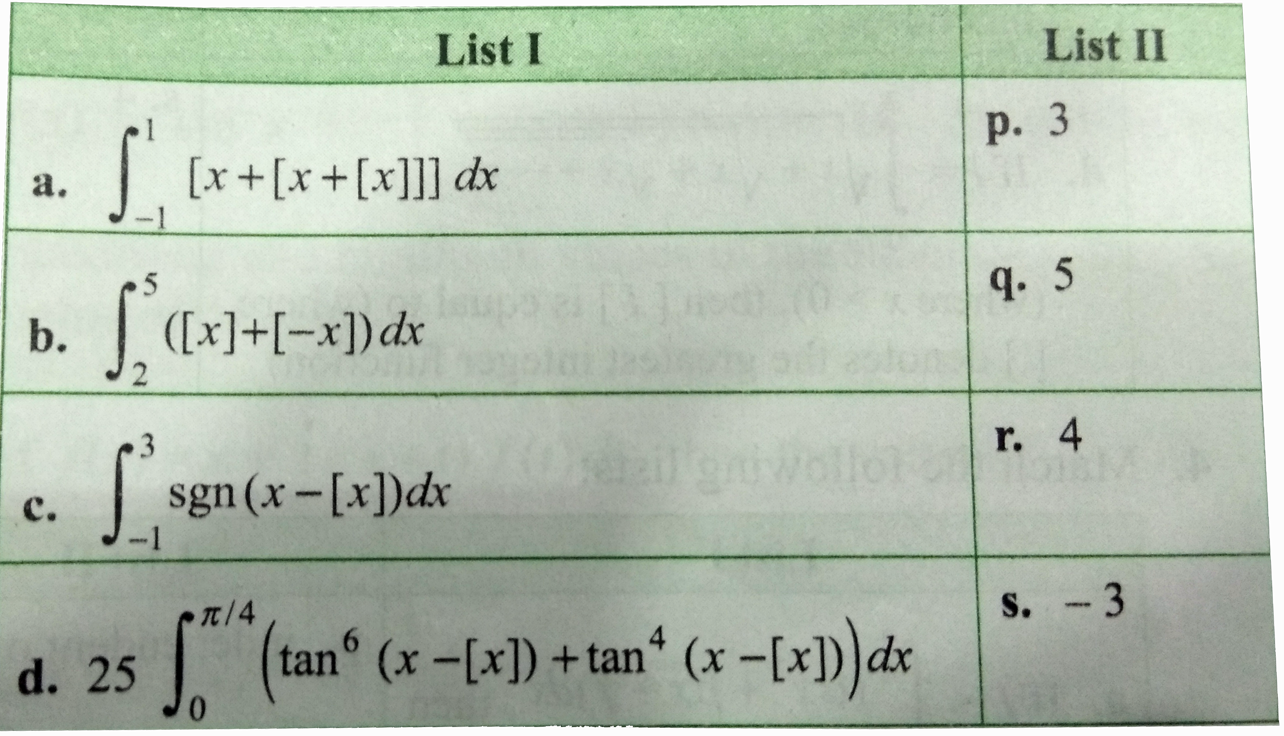{ . } denotes the fractional part function and [.] denotes the greatest integer function. Now, match the following lists:
![{ . } denotes the fractional part function and [.] denotes the greatest integer function. Now, match the following lists:](https://d10lpgp6xz60nq.cloudfront.net/physics_images/CEN_CAL_C01_E19_007_Q01.png)
Video Solution
Text Solution
The correct Answer is:a→s;b→r;c→s;d→p
a. f(x)=ecos4πx+x−[x]+cos2px
cos2πx and cos4πx have period 1.
x−[x]={x} has period 1.
Then the period of f(x) is 1
b. f(x)=cos2π{2x}+sin2π{2x}
The period of {2x} is 1/2. Then the period of f(x) is 1/2.
c. Clearly, tanπ[x]=0∀x∈R and the period of sin3π{x} is equal 1.
d. f(x)=3x−[3x+a]−b=3x+a−[3x+a]−(a+b)
={3x+a}−(a+b)
Thus, the period of f(x) is 1/3.
|
Topper's Solved these Questions
- RELATIONS AND FUNCTIONSBOOK - CENGAGECHAPTER - RELATIONS AND FUNCTIONSEXERCISE - Exercise (Numerical)
31 Videos
- RELATIONS AND FUNCTIONSBOOK - CENGAGECHAPTER - RELATIONS AND FUNCTIONSEXERCISE - JEE Previous Year
12 Videos
- RELATIONS AND FUNCTIONSBOOK - CENGAGECHAPTER - RELATIONS AND FUNCTIONSEXERCISE - Exercise (Comprehension)
32 Videos
- Quadratic Equations, Inequalities, Modulus and LogarithmsBOOK - CENGAGECHAPTER - Quadratic Equations, Inequalities, Modulus and LogarithmsEXERCISE - Question Bank
31 Videos
- SCALER TRIPLE PRODUCTS BOOK - CENGAGECHAPTER - SCALER TRIPLE PRODUCTS EXERCISE - DPP 2.3
11 Videos
Similar Questions
Knowledge Check
If F(x)=sinπ[x]{x} then F(x) is (where {.} denotes fractional part function and [.] denotes greatest integer function and sgn(x) is a signum function)
Aperiodic with fundamental period 1BevenCrange is singletonDindentical to sgn(sgn{x}√{x})−1If θ∈[−2011π,2011π], then the number of solutions of the equation.
[secθ−1]+{tanθtanθ2}
(where {.} denotes the fractional part function and [.] denotes the greatest integer function) isA0B2010C2011D2012If f(x)=[sin2x] ([.] denotes the greatest integer function), then
Af is everywhere continuousBf is everywhere differerntiableCf is a constant functionDnone of these
draw the graph of f(x)=x+[x], [.] denotes greatest integer function.
View SolutionThe period of 6x−[6x] is (where [ ] denotes the greatest integer function)
View SolutionIf [.] denotes the greatest integer function, then f(x)=[x]+[x+12]
View SolutionLet [.] denote the greatest integer function and f(x)=[tan2x]. Then
View SolutionIf [ ] denotes the greatest integer function, then [(√2+1)6) is equal
View Solution

